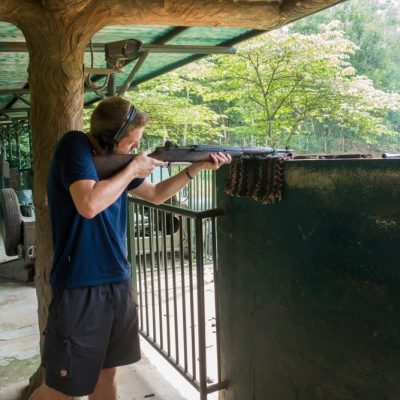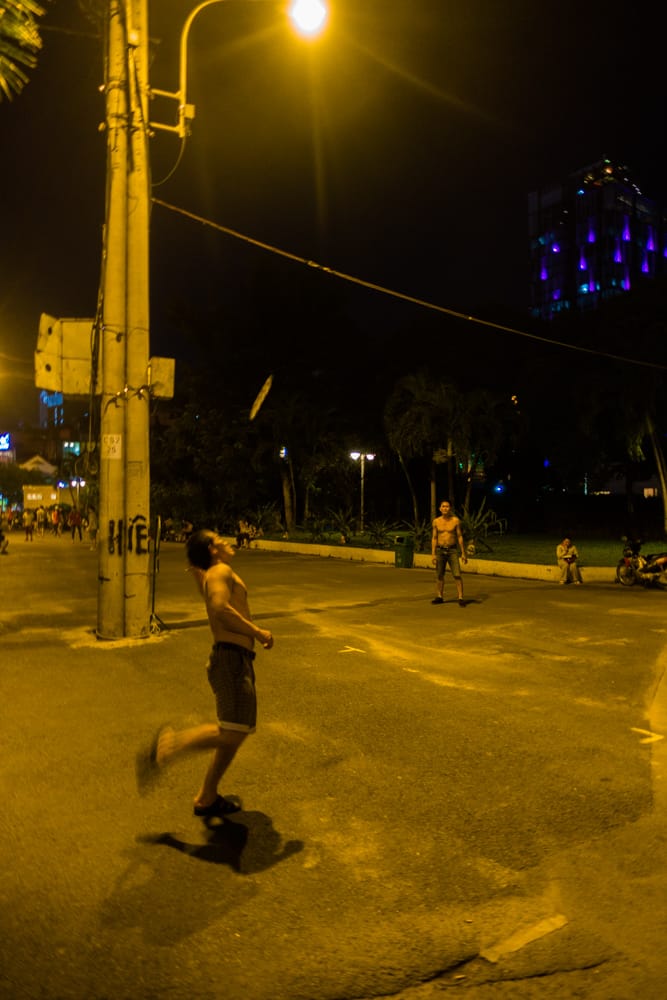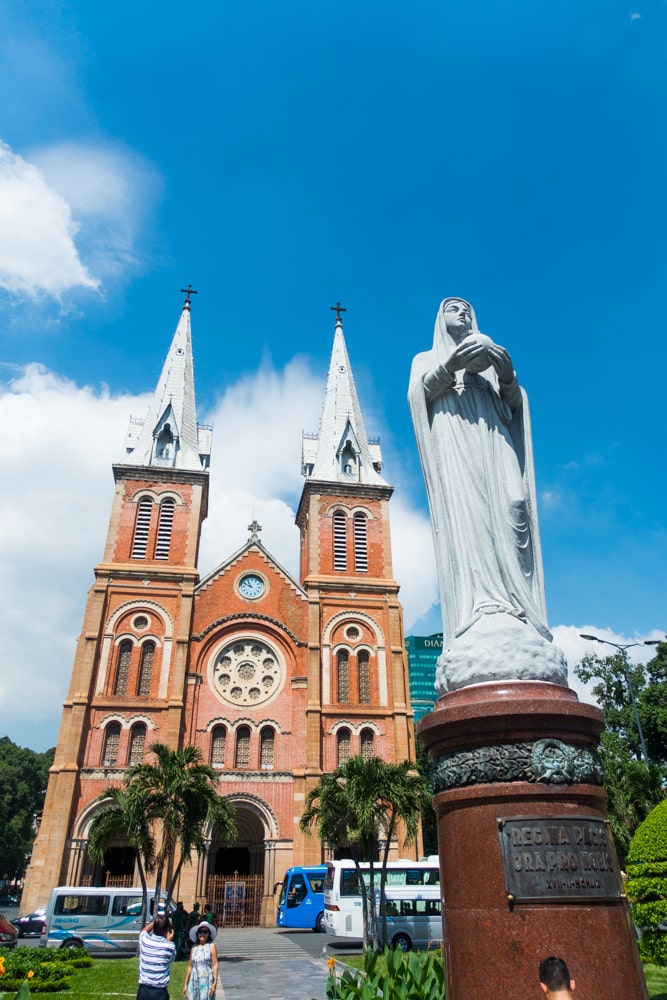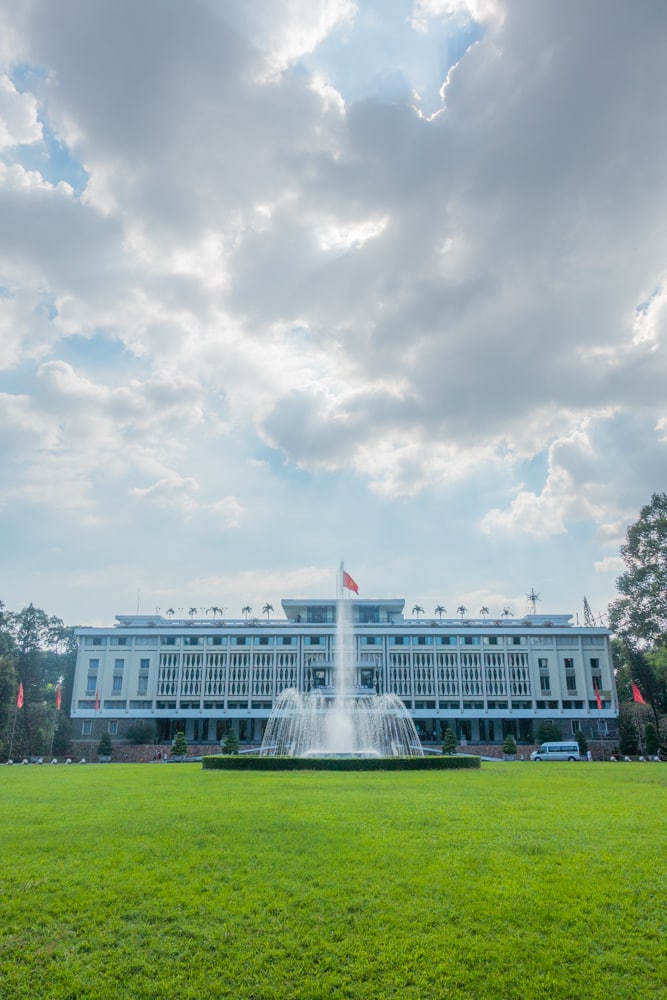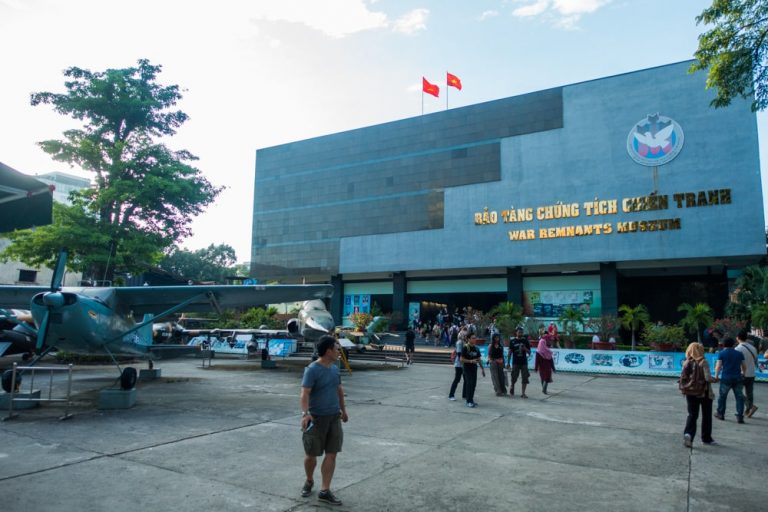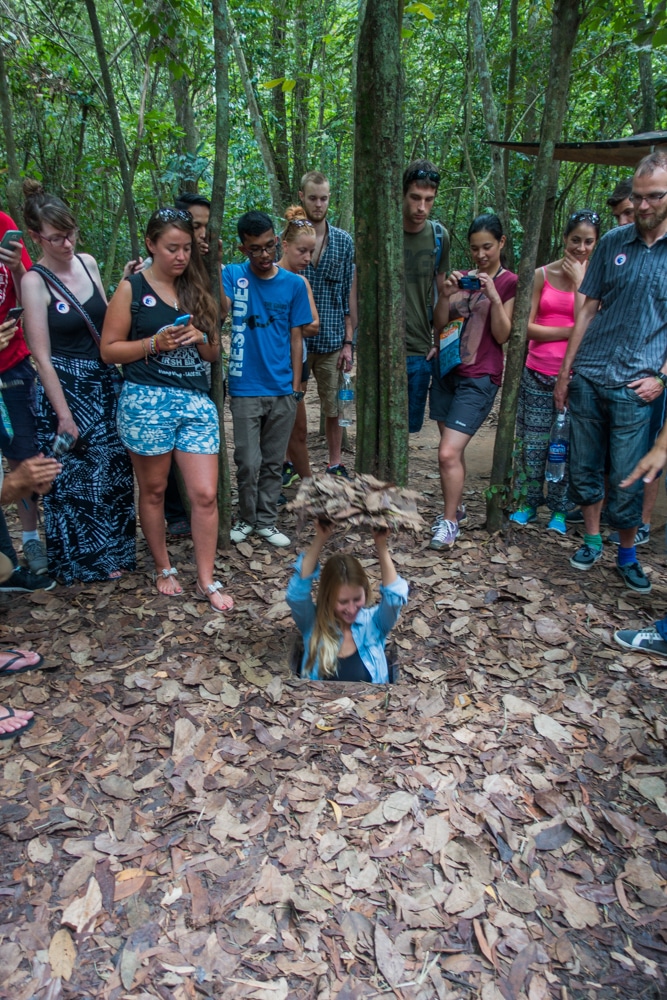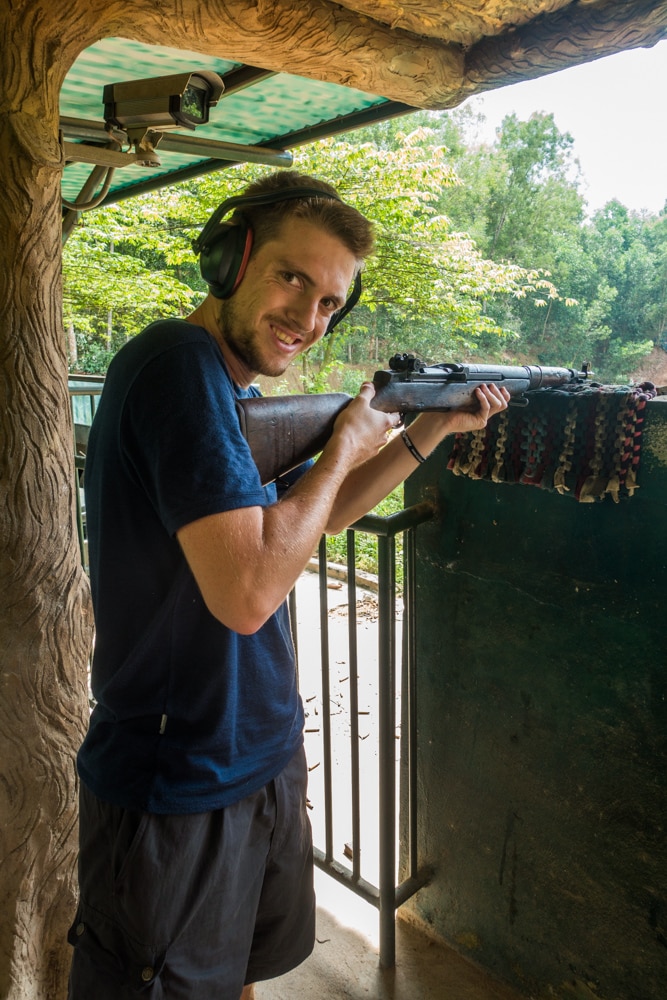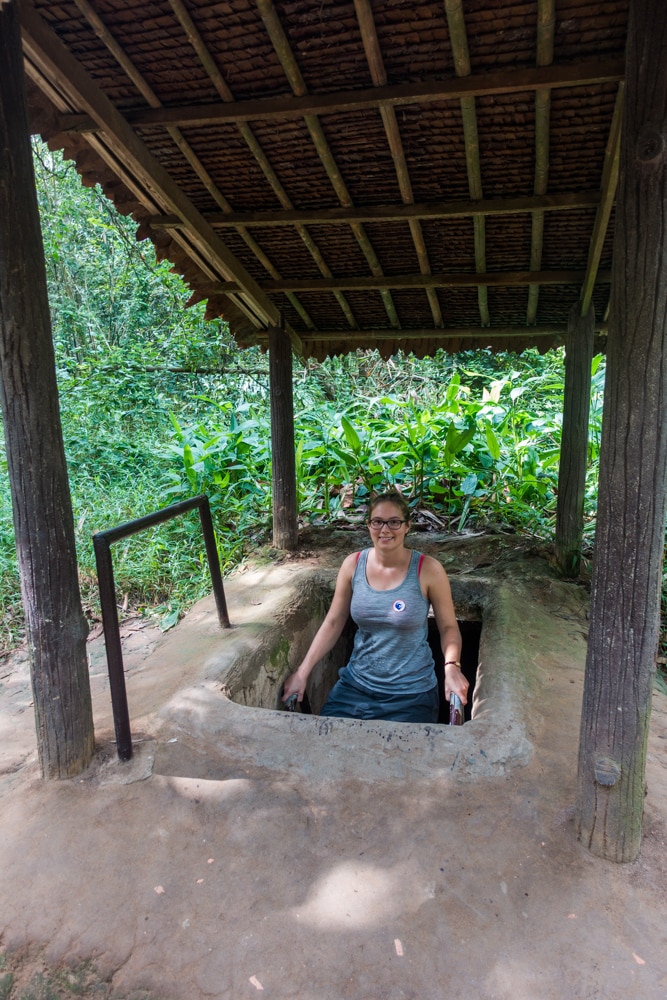We spent three full days in Ho Chi Minh City, also known as Saigon. It’s the largest city, although not the capital, of Vietnam. Timeless (read: small and dark) alleys crisscross between the busy streets, and old buildings full of character share the city with giant shiny shopping malls.
We experienced it as a lively city, hectic and full of traffic, although at the same time relaxed and full of people having a great time. You can’t get around the street vendors selling sunglasses, jewellery and food, and motorbikes are everywhere. Yet while walking through the various parks in the city, we had a sense of serenity. You seem to forget the bustling manner on the streets and see people relaxing, playing badminton, rollerblading, jogging and learning their kid how to ride a bike. We liked it!
Intrigued? Keep reading to find out what to see and do in Ho Chi Minh City.
TIP: The locations in this article are clickable and will take you to the corresponding marker on the map. You can find the map on the right of your screen, or by clicking the map icon on the bottom if you’re on mobile.
Join a highlights tour of Ho Chi Minh City
Although we didn’t do a highlights tour of Ho Chi Minh City during our visit, it’s now one of the first things we consider when visiting a new city. It can be a (free, read: tip-based) walking tour or a (motor)bike tour, whatever seems best for that particular city. It’s a good way to get to know the city.
We’ve selected 2 of the best options for a Ho Chi Minh City tour below.
We also found a rather unique cyclo tour of Ho Chi Minh City you might want to check out. Enjoy this tour along the most famous landmarks from a cyclo, otherwise known as a bicycle taxi.
Prefer a more off the beaten track tour with a local? TakeMeTour has got you covered. They offer an in-depth tour of Ho Chi Minh City by motorcycle or private car, either in the morning or afternoon. It includes a visit to a local market and a home cooked meal.
Admire its French colonial landmarks
We spent our first day walking around the city and exploring some of the major tourist attractions. We passed by two of the must see buildings in Ho Chi Minh City: the Central Post Office and the Notre Dame Cathedral, situated across from each other.
We saw a man with a tower of donut-like pastries on his head and a freshly wedded couple taking wedding pictures in front of the mighty cathedral. The cathedral seemed to be closed and we just took a peek inside the Central Post Office, so these two were scratched off of our list in about 15 minutes.
Visit some museums
Next, we visited two museums of the wide range offered in Ho Chi Minh City. We’d do them both again if we had to start over our visit, so we recommend you to visit them too.
Reunification Palace
The first museum we visited was the Reunification Palace, or Independence Palace, built from 1962 to 1966.
When it was still the Norodom Palace, the president of the Second Republic of Vietnam lived and worked here during the Vietnam War. Until a Vietnamese Liberation Army tank crashed through its gates and ended the war. Now, the building is a museum, while certain rooms are still used for government meetings and receptions.
Before entering the Reunification Palace, you’ll pass the majestic fountain and the army tanks lined up on the grass. We didn’t pay a guide to show us around, so we just wandered through the building, accidentally overhearing some facts from random guides showing groups around the palace.
The entrance fee is 40,000 VND (~ $1.75 ~ €1.60) per person, which gives you access to the palace and the surrounding grounds. Note that special exhibitions might require an extra fee. Tickets can be bought between 7:30-11:00 and 13:00-16:00. In total we were about 45 minutes on the grounds.
War Remnants Museum
The War Remnants Museum on the other hand, was something totally different. Although it also started with paying an entrance fee of 40,000 VND (~ $1.75 ~ €1.60) per person (ticket office hours: 7:30-11:30 and 13:30-16:30) and checking out some army tanks lined up in front of the building, once we passed those, (sh)it got real.
Left in front of the building, you could see remnants of the cells and folter equipment used by the French and American forces invading Vietnam. Foltering techniques are meticulously described and photos of victims make it all the more real. Especially the tiger cages still make my stomach turn when I get reminded of them. It all seems surreal.
Inside the main building, the proper order is to go from the upper to the ground floor, as indicated by the numbers. During our visit, the upper floor housed the Requiem Exhibition, a display of the last pictures taken by both foreign and Vietnamese journalists and photographers before becoming victim of the conflict. The numerous photos capture the war and its victims up close.
Another memorable, but horrible photo exhibition is the one displaying the (still lasting) consequences of Agent Orange and napalm bombs, among others. The children of people that got in touch with the chemicals suffer physical deformations of all kinds, just like their children and maybe generations longer. Everything is displayed uncensored and the fact that the end of it all was only 40 years ago, makes it even harder to stomach. It really got to us.
After about one hour and a half however, we reached the ground floor, which shows the evidence of international support for the antiwar movement. This sort of counteracts all the horror you’ve seen before and tries to end your visit on a positive note.
If you prefer a tour of the War Remnants Museum combined with the Ho Chi Minh City Museum and some others, check out this Private Must-See Museums Tour in Ho Chi Minh City.
Visit the Cu Chi Tunnels
To learn even more about (what we call) the Vietnam War, we booked a half day tour to the Cu Chi Tunnels through our guesthouse. It’s definitely one of the most popular things to do in Ho Chi Minh City. Back then it cost us 225,000 VND (~ $10 ~ €9) in total. The tour seemed to be organized by a tour company called YTC.
We were picked up on foot at our guesthouse at about 8:00 in the morning. After a while in a parked mini van, they moved us to a normal bus. Then finally, we left for our 2 hour drive to the Cu Chi Tunnels.
We made a pitstop at a workplace for victims of Agent Orange. We could see the people at work and buy some handmade souvenirs. Mickey, our tour guide, collected another 110,000 VND (~ $4.80 ~ €4.40) entrance fee per person from everyone on the bus, in order to decrease waiting times when buying the entrance tickets.
Once arrived at our destination, we started off with a short video on the Vietnam War and the Cu Chi Tunnels, followed by some more explanation by Mickey.
Next, Mickey gave us a tour around the grounds of this open air museum, showing us the differently hidden entrances and reconstructed chambers of the underground village we call the Cu Chi Tunnels.
We even went down and crawled our way through a tunnel. You could crawl on for several more meters, while the tunnel grew smaller, but we were glad to breathe fresh air again after only a couple of minutes down there. Image people living there for 28 days on end.
We also saw what kind of traps the Vietcong made for their enemies and what kind of tricks they used to throw them off their scent.
All through the tour we heard different kinds of gun shots. At the end of the tour we could see where they came from: a shooting range where visitors can try a variety of guns for a considerable amount of Vietnamese Dong. The noise was terribly loud, and I really couldn’t see the fun in it, but a large part of our group seemed eager to cough up the money and give it a go. Brecht shot 10 rounds with an M1 Garand for 300,000 VND (~ $13 ~ €12).
Our tour guide Mickey was funny, passionate and spoke decent English. Unfortunately the group was too large (more than 40 people) and not everyone could see and/or hear everything at all times. I, for example, missed the part about the traps, as I couldn’t see Mickey demonstrating them. Oh, and they forgot to tell us we had to bring lunch. At the shooting range there is a small shop where you can buy ice cream and cookies, but no decent lunch.
While we would recommend visiting the Cu Chi Tunnels, don’t book with the tour company we joined. If going again, we’d prefer this private motorbike tour to the Cu Chi Tunnels with a local for example. You can do that same tour by private car or shared mini van as well. Or go with a guided group tour to the Cu Chi Tunnels.
Taste the local cuisine on a food tour
Joining a food tour is always a good idea, especially if you have yet to get to know the local cuisine. We had already done a street food tour in Hanoi, but below you can find some great options for a Ho Chi Minh City food tour as well.
Another option is joining an evening food tour by motorcycle (or private car) by a local through TakeMeTour. The description just says you’ll get to enjoy many different local dishes together with the stories and tradition behind them. Sounds good to me!
Join a cooking class
If you rather have a hands-on experience with the local cuisine, a cooking class is right up your alley. Bonus: you’ll have yummy recipes to replicate back home!
Find a Ho Chi Minh City cooking class that suits your needs through Cookly. From a cooking class combined with a market tour, over a hands-on coffee experience, to a master chef class, their broad range of options makes choosing hard, I know. Read our guide on Cookly for more info on how to navigate this website.
We loved our visit to Ho Chi Minh City, although Ngoc Thao Guesthouse didn’t really live up to our expectations. However, the vibrant city with its beautiful buildings made up for that. Learning about their gruesome history just has to be part of it, otherwise you haven’t really visited Vietnam. Don’t you agree?

Like it? Pin it!
Did you find this post helpful? Help us spread the word by sharing this post or pinning the following image.


